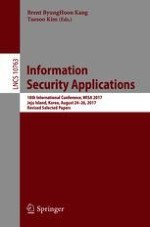2018 | Book
Information Security Applications
18th International Conference, WISA 2017, Jeju Island, Korea, August 24-26, 2017, Revised Selected Papers
Editors: Brent ByungHoon Kang, Taesoo Kim
Publisher: Springer International Publishing
Book Series : Lecture Notes in Computer Science
